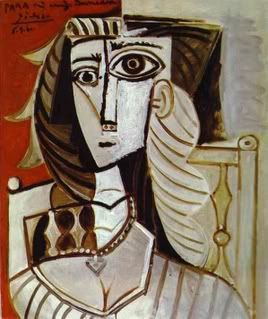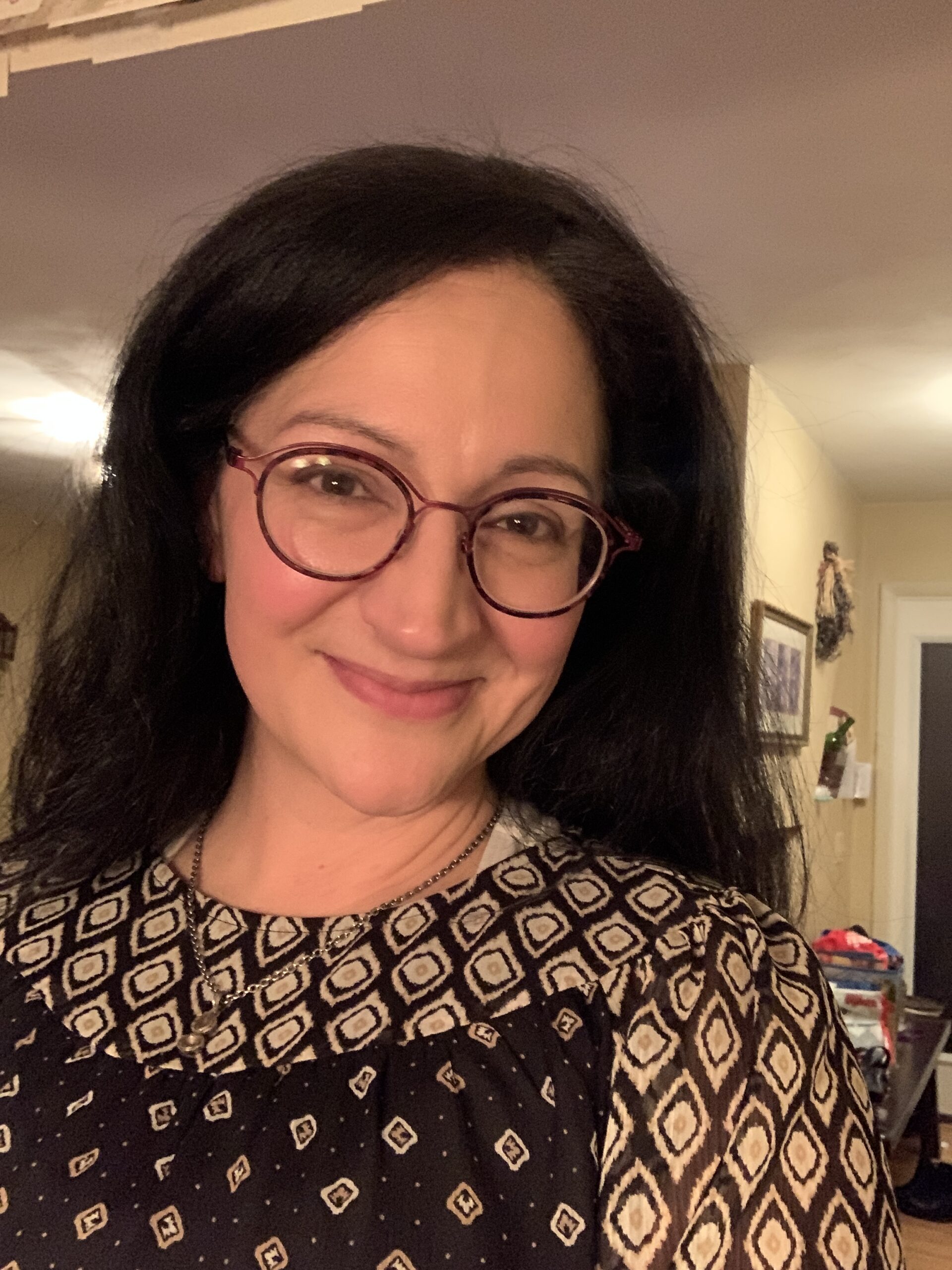Humanizing Bad Guys
By Therese Walsh | March 11, 2008 |
 I wish Donald Maass had revealed his exercise for making a bad guy spine-tinglingly good in our interview with him. Here’s what I do know: Bad guys with depth, who display relatable tendencies and characteristics, are more likely to affect us than will black-hatted, gun-toting baddies.
I wish Donald Maass had revealed his exercise for making a bad guy spine-tinglingly good in our interview with him. Here’s what I do know: Bad guys with depth, who display relatable tendencies and characteristics, are more likely to affect us than will black-hatted, gun-toting baddies.
Why?
It’s a little like this picture. We recognize a woman. Two eyes. Nose. Mouth. Cleavage. But why is her left eye so much bigger than her right? What’s going on with her ear, her neck? By identifying with the picture, we’re drawn more deeply into it, into trying to understand what’s “wrong” with it.
Same in fiction. Paint a character who’s very similar to what we recognize as normal: a man who likes his coffee freshly ground, whose favorite shirt has a hole in the pocket, who loves his dog, who calls his doctor at the first sign of a sinus infection. (This is fiction.) Take same man and add a dash of dysfunction: he rips a leaf off his wife’s favorite plant whenever he’s mad at her. We probably forgive him for this; he loves his dog, c’mon. But then, in chapter three, he looks out at the forest he can barely see from his office window, thinking about his loveless marriage, and wonders how many skulls he might find buried in the clay, if any of them are human. His thoughts flash to the spade he has in the garage, to his wife’s insurance policy. He wonders how many years it might take for a missing person’s policy to pay out. Holy… what? Still, the guy hasn’t really done anything wrong; he’s just thinking about it. Maybe he’s having a bad day. But now we’re on the road with him, wondering just how bad his marriage is, how cramped he feels in his own skin, how far he’ll go to find relief. Because he has a habit of forgetting his wallet on the counter, has an endearing dimple and rich laugh, pours too much cream into his coffee and loves his dog, we can relate to his life.
This, from Donald Maass’s Writing the Breakout Novel:
One-dimensional characters are flat, simply motivated and always act “in character,” that is, predictably. Fully rounded, three-dimensional characters have many sides, complex motives and act in ways that surprise us… in most novels nothing is lost, and everything is gained, by enriching the inner life of one’s cast… Developing fictional people is mainly a matter of opening oneself to real people, most of all to ourselves.
By far the most useful technique for character development is a simple principle that Anne Perry, among others, keeps in mind when building characters: “Like them.” It is hard to write someone you don’t know, harder still if you do not care for them. Eliminate characters whom you do not regard with warmth, to whom you are not drawn. The coldness you feel toward them will show in your writing.
By the way, the same mandate to like your characters may also go for your villain. Don’t you find the most interesting villains are the ones whose motives we can understand? The ones who are made evil by circumstances, rather than the ones who simply are born bad? Depth of characters in your opposition will make your writing more richly textured.
What habits or characteristics make your bad guys human? And who are your favorite bad guys in books and in the movies? How about Dr. Hannibal Lecter in Thomas Harris’ novel, The Silence of the Lambs? Vicomte Sébastien de Valmont in Dangerous Liaisons, written by Pierre-Ambrois-Francois Choderlos de Laclos? In film, what about Doc Oc (Alfred Molina) in Spider-Man 2?
Write on, all!










Teri,
Great advice. One of my favorite writers, Robert B. Parker, has crafted a sidekick, Hawk, to his hero, Spenser, who can be a “good guy” one minute and an enforcer and stone killer the next. Three-dimensional characters are the stuff of great writing, even when they’re the bad guys. Thanks for the reminder.
Hi Richard,
That sounds like a perfect example.
Another thing I could’ve mentioned here is that the bad guy is the hero of his own story. Good to keep that in mind.
T
I love anti-heroes.
Dexter, Mr. Brooks, Hannibal Lecter. They’re not entirely evil. They just have a very different kind of self-defined morality that your average person probably wouldn’t understand.
Especially in the U.S., some of our greatest heroes are rebels. Which is beginning to seem a bit ironic as some rebels could easily be termed “terrorists.”
You could call it humanizing the bad guys, or from another perspective it’s de-humanizing the good guys.
I think the baddies are scarier when they are humanized.
“Another thing I could’ve mentioned here is that the bad guy is the hero of his own story.”
That’s a great reminder, Therese. Excellent post (and troubling picture, lol).
Apt timing with the recent death of Dungeons & Dragons creator Gary Gygax, I always found character moral distinctions in that game to be useful towards fiction…
Lawful Good vs. Neutral Good vs. Chaotic Good.
Likewise on the other end of the spectrum you have Lawful Evil vs. Neutral Evil vs. Chaotic Evil.
Lawful meaning rule-bound, adhering to a kind of code, whether it be the laws of the land or the laws of the character’s own faction. Chaotic being the opposite end of the spectrum from that. A person who is either good or evil, but doesn’t adhere to rules in any case.
A more creatively broad way to interpret a character’s disposition.
I agree, Eric. Those labels provide a rich range of possibilities.
D&D provides a million writing ideas ^_^
When I write, I always try to humanize my bad guys. The “downside” I’ve noticed is that my bad guys are never “evil”. I’ll start out saying the character is going to be a puppy-murdering rapist, and start develving into their personality to find out why, then suddenly they aren’t murding puppies, they are trying to save the puppies from the heros who will enslave them as pets! No, my bad guy just wants a world where they are our animal friends, not pets! And given more time, I’d explain away the rapist tag as well.
Just like real life, I think tags are more given to “bad guys” by the good guys who want to villafy them so that its easier to go after them.
I’m thinking of Severus Snape and going farther back, Uriah Heep. Both are characters who have depths to them that make us want to know more. Twisted, yes, creepy, yes, but definitely interesting. Both have motives that are clear, but complicated.
I’ll start out saying the character is going to be a puppy-murdering rapist, and start develving into their personality to find out why, then suddenly they aren’t murding puppies, they are trying to save the puppies from the heros who will enslave them as pets!
LOL, Cassie!
Oh, Snape. How could I forget him? Luscious, greasy villain. Yes. Thanks for the reminder, Brenda.